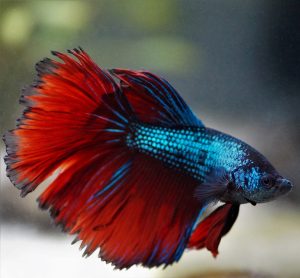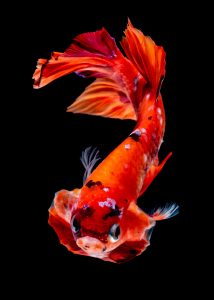When you think of fish and their anatomy, there’s probably a few things that come to mind.
First, you might think of their fins and scales, since those are often the most unique and eye-catching parts of fish.
Next, you might think about their gills. After that, though, you might not know what else makes fish special.
One thing that a lot of people don’t consider is the fact that fish have teeth. Fish teeth are considered rare, confined to only a certain number of species.
In fact, if you think of a fish with teeth, your first thought is probably of that of a piranha with their razor sharp teeth.
However, while it may come as a surprise, all fish, regardless of species or whether they live in freshwater or saltwater, have teeth. The only thing is, their teeth aren’t all the same.
You see, like with all animals, there are many factors that come into play when it comes to a fish’s teeth.
The shape of their teeth, as well as their location in the fish’s mouth, are dependent on many things, although, the number one factor is the fish’s diet.
It doesn’t come as a surprise that a fish that eats only meat will need different teeth than a fish that eats only plants, and that’s one of the coolest things about fish teeth.
To help you learn more, here is a complete guide to the different types and locations of different fish species’ teeth.
Carnivorous Fish Teeth
Think of the meat eating mammals in your life – cats, dogs, wolves, bears. What do all these animals have in common when it comes to their teeth? They’re sharp.
That comes at no surprise, though, of course, when you take a good look at their diet. Carnivorous fish are the same way.
Carnivorous fish are what is known as a heterotroph. ‘Hetero’ means other while ‘troph’ is derived from Greek to mean eater.
This just means that fish that fall into this category must eat other organisms in order to get the nutrients they need.
These others include a variety of other organisms such as plankton, shrimp, crabs, snails, insects, and even other species of fish.
Now, eating these kinds of organisms would be pretty hard with human teeth – which are, for the most part, dull and flat.
That’s why carnivorous fish have a set – or possible even sets depending on dental location, which will be discussed further below – of razor sharp incisors that are designed for ripping and tearing meat into edible sizes.
They also use their teeth to eat animals with hard shells, such as crabs and snails.
Flat, dull teeth would be useless against the shells of these animals, and that’s why having sharp teeth with a strong jaw are so important.
All of this doesn’t mean that carnivorous fish can’t eat plant matter, however; they just can’t digest it.
Carnivores have a shorter intestinal tract compared to herbivores and omnivores and a larger stomach that can hold something as large as an entire fish.
Their stomach is only designed with the specific anatomy and physiology to digest meats, so, even though they can and will eat plants, they do not have the ability to digest it and derive beneficial nutrients from it.
Examples of carnivorous fish include piranhas, sea basses, and tuna fish.
Omnivorous Fish Teeth
Omnivores are a bit tricky. They don’t only eat meat, but they also don’t only eat plants. This means that they need teeth somewhere in the middle of sharp for tearing and dull for grinding.
Before we start looking at omnivore fish and the anatomy of their teeth, let’s break this word down.
‘Omni’ means that all or of all things. ‘Vore’ indicates a group or biological community.
Thus, the word can come together to have a meaning of organisms who can gain nutritional value from all things, whether it’s meat or plant matter.
 Now, let’s take a look at an omnivorous mammal. In fact, I think you might know this one pretty well. That’s right – humans!
Now, let’s take a look at an omnivorous mammal. In fact, I think you might know this one pretty well. That’s right – humans!
Go to the nearest mirror and look at your teeth. You have your molars in the back, which are dull and flat. These are good for grinding and chewing.
Then, you have your canine teeth, which are sharp. These, of course, are for tearing and ripping meat and other rough materials.
Last, you have your front teeth, which fall a bit in between dull and sharp and are used for the initial tearing of food.
Omnivorous fish have very similar teeth due to their diet which includes other organisms such as insects or plants.
An example of omnivorous fish include the Pacu.
Herbivorous Fish Teeth
Herbivores, as the prefix ‘herb’ suggests, survive eating plant matter.
Like carnivores, they may sometimes stray from their traditional diet and consume other organisms and live food, but their main diet – and the diet they should eat mostly in order to be healthy – consists of plants, algae, fruit, and vegetables.
Herbivorous fish has dull, flat teeth, which, instead of chewing or tearing, allows them to grind their food.
They have no true stomach, so grinding food is important. Instead of a stomach, they have a specialized intestine that is designed specifically for breaking down plant matter to derive the nutrients.
A lack of a true stomach also means that they cannot store food, however, so they will have to eat multiple times a day.
Here’s an interesting fun fact about herbivorous fish: they help keep many of the popular ecosystems and coral reefs in check!
Coral reef ecosystems are in competition with kelp and algae for natural resources, and, by eating the plant matter, herbivorous fish benefit the coral reef by reducing competition from plant species.
Examples of herbivorous fish include surgeonfish and parrotfish, both of which can be found eating algae outside of coral reefs.
Different Dental Locations in Fish
Most animals that you know – humans, cats, dogs – only have teeth in one location: embedded in their jaws.
Fish, however, cna have teeth in multiple locations, such as on their lips, mouth, upper and lower jaws, tongue, and even in their throat, which are known as pharyngeal teeth after the pharynx.
Teeth Types of Common Pet Fish
Betta Fish
In the wild, betta fish are omnivores, eating both insects that fall into the water such as crickets, flies, grasshoppers, and larvae while also eating the algae on the surface of the water.
They are also known as territorial fish, especially males, so they have a mouthful of sharp teeth that are good for both eating and protecting themselves.
Goldfish
If you’ve ever taken a good look at your beloved pet goldfish, you might have noticed that they don’t have any teeth.
This isn’t because they don’t have them, however – they have pharyngeal teeth that remain unseen in their throats. These teeth are good for grinding up their food, rather than ripping and tearing.
Guppies
Guppies have multiple types of teeth fitted inside their tiny mouths – as well as a tongue!
They have teeth lining their upper and low jaws, the roof of their mouth, and, like goldfish, pharyngeal teeth lining their throats.
While there isn’t much jaw power behind these teeth, they efficiently grind up food so that the guppies can swallow and digest it.
Final Thoughts
 When it comes to neat and exciting animals in the world, fish are often left out. However, they have big personalities and are much more unique than they seem at first glance.
When it comes to neat and exciting animals in the world, fish are often left out. However, they have big personalities and are much more unique than they seem at first glance.
Each species is designed specifically for their environment, and, while this is obvious from a glance at their fins and scales, you can also see this in their teeth.
When you consider each species of fish’s diet, you’ll begin to be able to understand the pattern.
Carnivores have sharp teeth lining their upper and lower jaws where they have the most force so that they can rip and tear meat from their prey, which includes everything from insects like crickets to even other species of fish.
Herbivores need more grinding power than raw jaw strength, so they have flat molars in their jaws and even in their throats and the roofs of their mouth.
This helps make sure that they can break through the cell wall of the plant cells to get to the nutrients that are inside the plant that otherwise may be unreachable during digestion.
And omnivores, due to the fact that their diets are a mix of plants and other organisms, have a variety of teeth types.
Learning about fish can be a fun and exciting experience just because not much about them is common knowledge.
Knowing the different teeth types, however, is also important when considering what species to put in a community tank, as different types of eaters will need food at different times.
For example, due to the fact they don’t have a stomach, herbivores will need food more often than carnivores – an important fact to take into account when setting up a tank.
